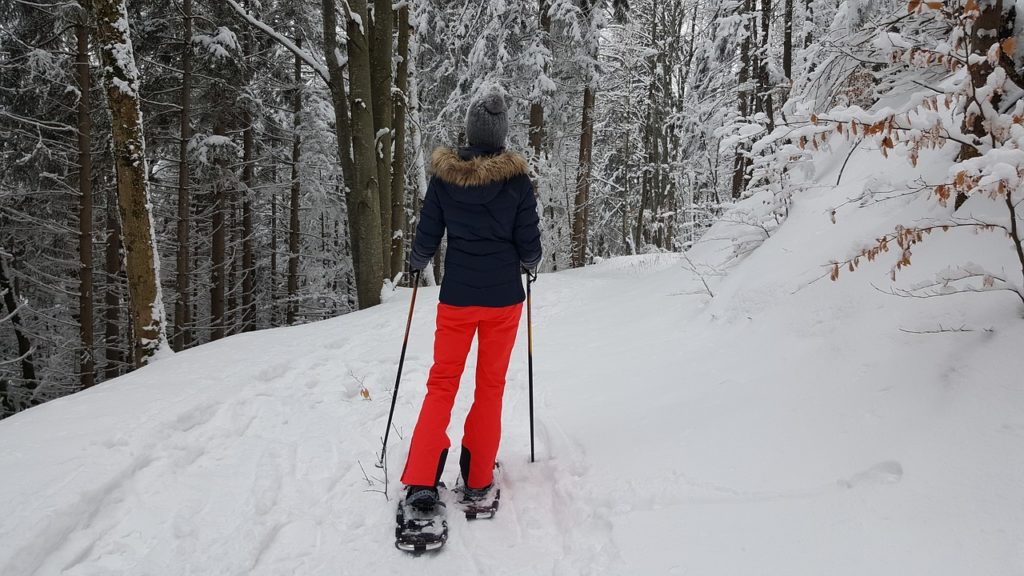You don’t have to drive to the hills of New Hampshire for wintertime adventure. Snowshoeing along Yarmouth’s conservation trails is a terrific way to enjoy the outdoors, without traveling off Cape or spending a mountain of money. Of course you do need snow.

Cape Cod’s winters are milder than most of New England because the peninsula is nearly surrounded by water. But late in the season, when ocean temperatures dip below 40 degrees Fahrenheit in February and early March, coastal storms can bring the kind of heavy precipitation that summons snowplows and covers the landscape in a deep, white blanket.
Getting into the woods with snowshoes to enjoy the winter landscape can make you feel like a child again, opening the senses to unfamiliar sights and sounds – fresh fox and rabbit tracks along the path, the plop of snow clumps falling from branches, the winter call of black-capped chickadees (hey, sweetie), and the open vistas of ponds that were previously hidden by dense, summer foliage.
Snowshoeing is also a great aerobic exercise. It’s a low-impact activity that’s almost as natural as walking. But snowshoes are big and flat, so they require a wider stance, which puts extra work for the thighs and glutes. And it burns a blizzard of calories. Depending on the intensity and pace, a 160-pound person expends some 600 calories an hour while snowshoeing.

On Cape Cod, where much of the terrain is flat, you can get by with an entry-level pair of trail snowshoes for $130 to $200. Trail snowshoes are made for cruising along wide paths and rolling or flat terrain, as opposed to off-trail snowshoes, which improve performance on steep hills or when maneuvering around trees, logs and other obstacles, says Cliff Irving, a guide at Eastern Mountain Sports in Hyannis.
Trail snowshoes will adjust to fit multiple styles of winter hiking boots, so you don’t need to spend additional money for footwear, as long as the boots you own are sturdy, warm and waterproof. They should also be high enough to provide ankle support and keep out the snow.
If you don’t already have trekking poles for hiking, Irving advises buying a pair with basket attachments for snow. In addition to helping with balance, trekking poles allow you to cruise along with a rhythmic cross-country ski motion that gets the heart pumping. And when you want to test a patch of ice that may be concealing a deep puddle, you can poke it with a pole before stepping down. Finally, a pair of trekking poles poked into the snow makes a great place to hang your gloves when grabbing a drink or an energy bar.
Some other gear tips from Irving:
- Gaiters are a good option for keeping snow out of your boots, especially if your boots are cut low (just above the ankles).
- Bring an extra pair of socks with you when taking a long trip. If you stop for lunch and a drink, you can change out your socks to keep your feet dry and warm for the trek home.
- Don’t buy snowshoes that are too big. Most guides recommend adding the weight of a 20- or 30-pound pack to your own weight, and buying a shoe that will support that load. But if you’re not likely to be carrying a heavy pack, you might get by with a smaller snowshoe that will be easier to maneuver.
Once you have the gear, getting outdoors is simply a matter of dressing for the weather (think layers) and heading to your favorite trail. In Yarmouth, that could mean the Cape Cod Rail Trail or one of the town’s many conservation areas, where paths meander through woodlands, around ponds, and across frozen salt marshes.

The Cape Cod Rail Trail is an easy place for beginners, with flat terrain and room to move. The surface isn’t plowed, so bike traffic is minimal, save for a few hardy riders on fat-tire bikes. The only drawback is that you’ll eventually encounter roads, which will require removal of skis or snowshoes and stepping over the snowplow ridges to cross. The website has a link to a downloadable trail map, where you can look for long, uninterrupted stretches.
The Callery Darling Conservation Area, located north of Route 6A is fairly flat and easy to navigate, making it a good place for snowshoeing or cross-country skiing, said Bill Bonnetti, field supervisor for the Yarmouth Division of Natural Resources. It also has a 130-foot boardwalk over the marshes and some scenic vistas along the trails.
Horse Pond Conservation Area features trails that wander through some 400 acres of town-owned land, just east of Higgins Crowell Road. The terrain is a little more challenging, but it’s a popular spot, along with the adjoining well fields, which are owned by the town’s Water District, Bonnetti said.
The Raymond J. Syrjala Conservation Area, off Winslow Gray Road, just north of Route 28, is also flat and easy to navigate, Bonnetti said. One side backs up to Water Department property, and the other side connects to town-owned cranberry bogs that are leased to growers. Bonnetti said roadways surrounding the bogs are open to the public, as long as visitors stay off the bogs and away from growing operations.
Dennis Pond, Sandy Pond and the Bud Carter Conservation Areas have steeper terrain with some rocks, which might be more difficult to navigate under a blanket of snow, Bonnetti said.

Those who use the conservation trails after a storm should call the Yarmouth Division of Natural Resources at 508-760-4800 if they see any issues – downed trees or blocked access, Bonnetti said.
The same rules apply for conservation land during winter as in summer he added. Trails are open from sunrise to sunset, dogs are allowed on leashes, no motorized vehicles are permitted and there are no campfires. Find more about rules for Yarmouth’s conservation land online.
Learn about fall and winter bird-watching along Yarmouth’s Conservation Areas (featured in a November blog at the Yarmouth Chamber of Commerce website).
Andy Tomolonis is a nonfiction author, travel writer and multimedia journalist.

